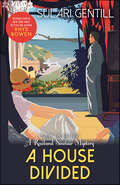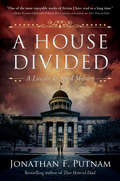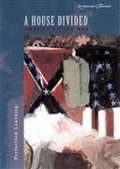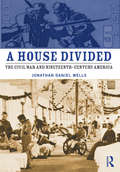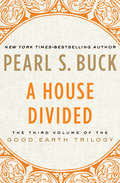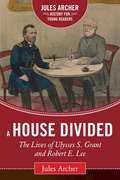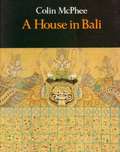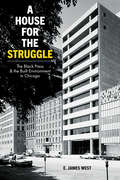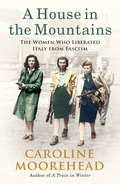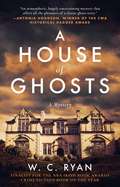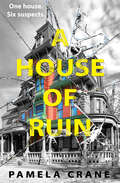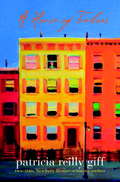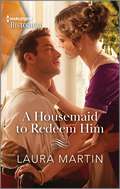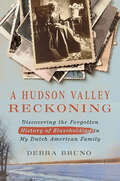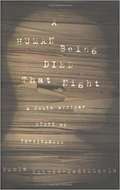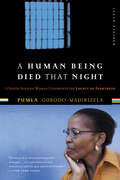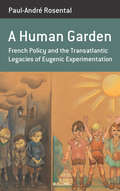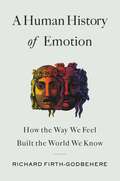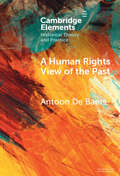- Table View
- List View
A House Divided (Rowland Sinclair WWII Mysteries #1)
by Sulari GentillIn Depression-era Australia, a gentleman painter from a wealthy family turns amateur sleuth when his uncle is murdered in this mystery series debut.From the USA Today–bestselling author of The Woman in the Library Rowland Sinclair doesn&’t fit with his family. His conservative older brother, Wilfred, thinks he&’s reckless, a black sheep; his aging mother thinks he&’s her son who was killed in the war. Only his namesake Uncle Rowly, a kindred spirit, understands him—and now he&’s been brutally murdered in his own home. The police are literally clueless, and so Rowly takes it upon himself to crack the mystery of the murder. In order to root out the guilty party, he uses his wealth and family influence to infiltrate the upper echelons of both the old and the new guard, playing both against the middle in a desperate and risky attempt to find justice for his uncle. With his bohemian housemates—a poet, a painter, and a free-spirited sculptress—watching his back, Rowly unwittingly exposes a conspiracy that just might be his undoing. The first novel in the Rowland Sinclair WII Mysteries introduces an amateur sleuth with wit, heart, and a knack for solving inscrutable crimes. This historical mystery by a USA Today–bestselling, award-winning author will appeal to fans of Rhys Bowen, Kerry Greenwood, and Jacqueline Winspear. (Previously published as A Few Right Thinking Men) Praise for A House Divided&“As series-launching novels go, this one is especially successful. . . . And Sinclair himself is a delight: wining us over completely and making us feel as though he&’s an old friend.&” —Booklist (starred review)&“While the vintage Down Under settings might make this debut, which was short-listed for the Commonwealth Writers&’ Prize Best First Book, comparable to Kerry Greenwood&’s Melbourne-based Phryne Fisher 1920s mysteries, Gentill works in historical events that add verisimilitude to her story. There are more political machinations going on here than Phryne could ever contemplate. . . . [Gentill&’s] witty hero will delight traditional mystery buffs.&” —Library Journal (starred review)
A House Divided: A Lincoln and Speed Mystery (A Lincoln and Speed Mystery)
by Jonathan F. PutnamThe new arrival of a woman named Mary Todd wedges a rift between Abraham Lincoln and Joshua Speed, but they must resolve their differences if they stand any chance of cracking one of the most harrowing murder cases they have ever faced.In the winter of 1839, a sensational disappearance rocks Springfield, Illinois, as headlines announce a local man has accused his two brothers of murder. Not one to pass up an opportunity, Abraham Lincoln takes up the case of the accused with the assistance of his best friend Joshua Speed to search for evidence of innocence.But just as soon as they begin, Lincoln and Speed find their friendship at grave risk of rupture as they vie for the hand a beautiful new arrival in town: an ambitious, outspoken young woman named Mary Todd. As the trial arrives, can Lincoln and Speed put aside their differences to work together for justice once more? An innocent man’s life may be in the balance—and nothing is as it seems.Re-imagining one of the greatest unsolved murder mysteries from Abraham Lincoln’s real-life trial cases, A House Divided is the most captivating Lincoln and Speed mystery yet from expert Lincoln scholar Jonathan F. Putnam.
A House Divided: America's Civil War
by Perfection LearningThe book discusses on America's Civil War. Part of the Literature & Thought series.
A House Divided: The Civil War and Nineteenth-Century America
by Jonathan Daniel WellsThe Civil War is one of the most defining eras of American history, and much has been written on every aspect of the war. The volume of material available is daunting, especially when a student is trying to grasp the overall themes of the period. Jonathan Wells has distilled the war down into understandable, easy-to-read sections, with plenty of maps and illustrations, to help make sense of the battles and social, political, and cultural changes of the era. Presented here is information on: the home front the battles, both in the East and the West the status of slaves women’s role in the war and its aftermath literature and public life international aspects of the war and much more! Students will also find helpful study aids on the companion website for the book. A House Divided provides a short, readable survey of the Civil War and the Reconstruction period afterward, focusing not only on the battles, but on how Americans lived during a time of great upheaval in the country’s history, and what that legacy has meant to the country today.
A House Divided: The Civil War and Nineteenth-Century America
by Jonathan Daniel WellsConsolidating one of the most complex and multi-faceted eras in American History, this new edition of Jonathan Wells’s A House Divided unifies the broad and varied scholarship on the American Civil War. Amassing a variety of research, this accessible and readable text introduces readers to both the war and the Reconstruction period, and how Americans lived during this time of great upheaval in the country's history. Designed for a variety of subjects and teaching styles, this text not only looks at the Civil War from a historical perspective, but also analyzes its ramifications on the United States and American identities through the present day. This second edition has been updated throughout, incorporating new scholarship from recent studies on the Civil War era, and includes additional photographs and maps (now incorporated throughout the text), updated bibliographies, and a supplementary companion website.
A House Divided: The Good Earth, Sons, And A House Divided (The Good Earth Trilogy #3)
by Pearl S. BuckA man returns to his native China to find upheaval in both his homeland and his family in this novel by a New York Times–bestselling author. On the eve of a popular rebellion, the Chinese government starts to crack down in cities across the country. Fleeing the turmoil, Wang Yuan, the son of a famous general and grandson of the patriarch of The Good Earth, leaves for America to study agriculture. When he returns to China six years later, he encounters a nation still in the grip of violent uprisings. Unprepared for the social upheaval, Wang is torn by the tensions between old traditions and new ways, and by his formidable family, whose struggles he hopes to solve. A reflective finale to Buck&’s groundbreaking and bestselling trilogy, A House Divided is a rich and unforgettable portrait of a family—and a nation—in transition. This ebook features an illustrated biography of Pearl S. Buck including rare images from the author&’s estate.
A House Divided: The Lives of Ulysses S. Grant and Robert E. Lee (Jules Archer History for Young Readers)
by Jules ArcherA House Divided is an exciting introduction to two of the most fascinating players in the American Civil War. Ulysses S. Grant was gruff and sloppy, the son of a hardworking but uneducated man opposed to slavery. Robert E. Lee, a slave owner himself, was a polite, aristocratic Virginia gentleman who descended from the Revolutionary War hero "Light-Horse Harry. ” Both men studied at West Point but developed very different tactics--Lee proved to be a careful strategist who made brilliant use of standard military tactics, while Grant was instinctive, spontaneous, and unconventional. Pitted against one another, the two became the most influential players in the bloodiest and most wrenching episode of American history. In alternating chapters, historian Jules Archer begins by exploring their formative years and early careers all the way through their postwar lives. Archer focuses on the men’s roles during the Civil War, detailing down to specific battles and decisions made by each man. Perfect for reluctant young historians as well as history-buffs-to-be. Part of the Jules Archer History for Young Readers series by Sky Pony Press, this book is guaranteed to inspire interest in a crucial piece of American history
A House Full of Females: Plural Marriage and Women's Rights in Early Mormonism, 1835-1870
by Laurel Thatcher UlrichFrom the author of A Midwife's Tale, winner of the Pulitzer Prize and the Bancroft Prize for History, and The Age of Homespun--a revelatory, nuanced, and deeply intimate look at the world of early Mormon women whose seemingly ordinary lives belied an astonishingly revolutionary spirit, drive, and determination. A stunning and sure-to-be controversial book that pieces together, through more than two dozen nineteenth-century diaries, letters, albums, minute-books, and quilts left by first-generation Latter-day Saints, or Mormons, the never-before-told story of the earliest days of the women of Mormon "plural marriage," whose right to vote in the state of Utah was given to them by a Mormon-dominated legislature as an outgrowth of polygamy in 1870, fifty years ahead of the vote nationally ratified by Congress, and who became political actors in spite of, or because of, their marital arrangements. Laurel Thatcher Ulrich, writing of this small group of Mormon women who've previously been seen as mere names and dates, has brilliantly reconstructed these textured, complex lives to give us a fulsome portrait of who these women were and of their "sex radicalism"--the idea that a woman should choose when and with whom to bear children.From the Hardcover edition.
A House In Bali [Illustrated Edition]
by Colin McpheeIncludes 39 photographs taken by the author during his time in Bali.A young American composer, quite by accident, heard some gramophone records of Balinese gamelan music that were to change his life completely. Such was his fascination that he ‘wanted to hear every gamelan in the countryside’. This book is an account of his stay in Bali just before the Pacific War. A House in Bali merits republication because of its sympathetic and often amusing account of the author’s involvement in Balinese society. While the author’s musical interests take up a considerable part of the narrative, music was itself such an integral part of Balinese life that the reader gets an overall impression of life on the island. Much has been written on the art of Bali and by artists but this is the only narrative by a musician and stands in its own right as a worthwhile period piece.
A House In Gross Disorder: Sex, Law, And The 2nd Earl Of Castlehaven
by Cynthia B. HerrupSex, privilege, corruption, and revenge--these are elements that we expect to find splashed across today's tabloid headlines. But in 17th century England, a sex scandal in which the 2nd Earl of Castlehaven was executed for crimes so horrible that "a Christian man ought scarce to name them" threatened the very foundations of aristocratic hierarchy. In A House in Gross Disorder , Cynthia Herrup presents a strikingly new interpretation both of the case itself and of the sexual and social anxieties it cast into such bold relief. Castlehaven was convicted of abetting the rape of his wife and of committing sodomy with his servants. More than that, he stood accused of inverting the natural order of his household by reveling in rather than restraining the intemperate passions of those he was expected to rule and protect. Herrup argues that because an orderly house was considered both an example and endorsement of aristocratic governance, the riotousness presided over by Castlehaven was the most damning evidence against him. Castlehaven himself argued that he was the victim of an impatient son, an unhappy wife, and courtiers greedy for his lands. Eschewing simple conclusions about guilt or innocence, Herrup focuses instead on the fascinating legal, social and political dynamics of the case and its subsequent retellings. In prose as riveting as the moral and legal dramas it depicts, A House in Gross Disorder reconsiders a scandal that still speaks to contemporary anxieties about sex, good governance, and the role of law in regulating both.
A House for the Struggle: The Black Press and the Built Environment in Chicago
by E. James WestBuildings once symbolized Chicago's place as the business capital of Black America and a thriving hub for Black media. In this groundbreaking work, E. James West examines the city's Black press through its relationship with the built environment. As a house for the struggle, the buildings of publications like Ebony and the Chicago Defender embodied narratives of racial uplift and community resistance. As political hubs, gallery spaces, and public squares, they served as key sites in the ongoing Black quest for self-respect, independence, and civic identity. At the same time, factors ranging from discriminatory business practices to editorial and corporate ideology prescribed their location, use, and appearance, positioning Black press buildings as sites of both Black possibility and racial constraint. Engaging and innovative, A House for the Struggle reconsiders the Black press's place at the crossroads where aspiration collided with life in one of America's most segregated cities.
A House in the Homeland: Armenian Pilgrimages to Places of Ancestral Memory (Worlding the Middle East)
by Carel BertramA powerful examination of soulful journeys made to recover memory and recuperate stolen pasts in the face of unspeakable histories. Survivors of the Armenian Genocide of 1915 took refuge across the globe. Traumatized by unspeakable brutalities, the idea of returning to their homeland was unthinkable. But decades later, some children and grandchildren felt compelled to travel back, having heard stories of family wholeness in beloved homes and of cherished ancestral towns and villages once in Ottoman Armenia, today in the Republic of Turkey. Hoping to satisfy spiritual yearnings, this new generation called themselves pilgrims—and their journeys, pilgrimages. Carel Bertram joined scores of these pilgrims on over a dozen pilgrimages, and amassed accounts from hundreds more who made these journeys. In telling their stories, A House in the Homeland documents how pilgrims encountered the ancestral house, village, or town as both real and metaphorical centerpieces of family history. Bertram recounts the moving, restorative connections pilgrims made, and illuminates how the ancestral house, as a spiritual place, offers an opening to a wellspring of humanity in sites that might otherwise be defined solely by tragic loss. As an exploration of the powerful links between memory and place, house and homeland, rupture and continuity, these Armenian stories reflect the resilience of diaspora in the face of the savage reaches of trauma, separation, and exile in ways that each of us, whatever our history, can recognize.
A House in the Mountains: The Women Who Liberated Italy from Fascism (The Resistance Quartet #4)
by Caroline MooreheadThe acclaimed author of A Train in Winter returns with the final volume in her Resistance Quartet—the powerful and inspiring true story of the women of the partisan resistance who fought against Italy’s fascist regime during World War II.In the late summer of 1943, when Italy broke with the Germans and joined the Allies after suffering catastrophic military losses, an Italian Resistance was born. Four young Piedmontese women—Ada, Frida, Silvia and Bianca—living secretly in the mountains surrounding Turin, risked their lives to overthrow Italy’s authoritarian government. They were among the thousands of Italians who joined the Partisan effort to help the Allies liberate their country from the German invaders and their Fascist collaborators. What made this partisan war all the more extraordinary was the number of women—like this brave quartet—who swelled its ranks.The bloody civil war that ensued pitted neighbor against neighbor, and revealed the best and worst in Italian society. The courage shown by the partisans was exemplary, and eventually bound them together into a coherent fighting force. But the death rattle of Mussolini’s two decades of Fascist rule—with its corruption, greed, and anti-Semitism—was unrelentingly violent and brutal. Drawing on a rich cache of previously untranslated sources, prize-winning historian Caroline Moorehead illuminates the experiences of Ada, Frida, Silvia, and Bianca to tell the little-known story of the women of the Italian partisan movement fighting for freedom against fascism in all its forms, while Europe collapsed in smoldering ruins around them.A House in the Mountains features black-and-white photographs throughout.
A House in the Mountains: The Women Who Liberated Italy from Fascism (The\resistance Quartet Ser. #4)
by Caroline MooreheadThe extraordinary story of four courageous women who helped form the Italian Resistance against the Nazis and the Fascists during the Second World War.In the late summer of 1943, when Italy changed sides in WWII and the Germans, now their enemies, occupied the north of the country, an Italian Resistance was born. Ada, Frida, Silvia and Bianca were four young Piedmontese women who joined the Resistance, living secretively in the mountains surrounding Turin. They were not alone. Between 1943 and 1945, as the Allies battled their way north, thousands of men and women throughout occupied Italy rose up and fought to liberate their country from the German invaders and their Fascist collaborators. What made the partisan war all the more extraordinary was the number of women in its ranks. The bloody civil war that ensued across the country pitted neighbour against neighbour, and brought out the best and worst in Italian society. The courage shown by the partisans was exemplary, and eventually bound them together as a coherent fighting force. And the women's contribution was invaluable--they fought, carried messages and weapons, provided safe houses, laid mines and took prisoners. Ada's house deep in the mountains became a meeting place and refuge for many of them. The death rattle of Mussolini's two decades of Fascist rule--with its corruption, greed and anti-Semitism--was unrelentingly violent and brutal, but for the partisan women it was also a time of camaraderie and equality, pride and optimism. They would prove, to themselves and to the world, what resolve, tenacity and above all exceptional courage could achieve.
A House of Ghosts: A Gripping Murder Mystery Set in a Haunted House
by W. RyanFinalist for the Irish Book Award for Crime Fiction Book of the Year, a Classic Cozy Big-House Mystery Haunted by the Specters of World War One—For Readers of Agatha Christie and Simone St. James Winter 1917. As the First World War enters its most brutal phase, back home in England, everyone is seeking answers to the darkness that has seeped into their lives. At Blackwater Abbey, on an island off the Devon coast, armaments manufacturer Lord Highmount has arranged a spiritualist gathering to contact his two sons, both of whom died at the front. Among the guests, two have been secretly dispatched from the intelligence service: Kate Cartwright, a friend of the family who lost her beloved brother at the Somme and who, in the realm of the spiritual, has her own special gift; and the mysterious Captain Donovan, recently returned from Europe. Top secret plans for weapons developed by Lord Highmount’s company have turned up in Berlin, and there is reason to believe enemy spies will be in attendance. As the guests arrive, it becomes clear that each has something they would rather keep hidden. Then, when a storm descends, they find themselves trapped on the island. Soon one of their number will die. For Blackwater Abbey is haunted in more ways than one . . . . An unrelenting, gripping mystery, packed with twists and turns and a kindling of romance, A House of Ghosts is the perfect cold-weather read.
A House of Knives: the second Breen & Tozer mystery set in the corrupt underground of 60's London (Breen and Tozer #2)
by William ShawGET HIGH. FALL FAR.'Big treat in store for fans. And if you're not a fan yet, why not?' Val McDermid'Utterly nails the myth of the Swinging Sixties' Sun The Black SheepThe wayward son of a rising MP is mutilated and burnt in suspicious circumstances. The Honest DetectiveDS Cathal Breen dodges political embargo and death threats to pursue the case. The Rolling StoneNotorious art dealer Robert Fraser may provide the only clue - if only he will talk.And as Breen slips deeper into London's underground of hippies and heroin, he edges nearer to the secrets of those at the very top. Banished from a corrupt and fracturing system, he will finally be forced to fight fire with fire.
A House of Ruin: A Clue-like Whodunit Mystery for Fans of Agatha Christie (The Ruin Series)
by Pamela CraneA murder that stole 1982 national headlines: “Renowned Family Slayed in Home.”A case that remained cold for forty long years.The Eyler family was anything but average. The father a top literary agent and the mother a duchess, they thrived in their prestigious Oakmont mansion surrounded by luxury…and secrets. Secrets that would eventually cost them their lives.On a cold autumn night, their legacy ended with a grisly massacre in one of the most horrific scenes ever investigated. Soon details splashed across every newspaper of how the family of five lay slaughtered in their library, cursing the mansion as it became branded the Execution Estate. With no witnesses and no motives, the killer remained free. The case grew colder. Speculations grew darker. Answers grew dimmer.Until now.Former estate manager, Derl Newman, steps forward four decades later with a suspicion and a clue that could lead investigators to finally solve the puzzle of why a killer would murder a family yet leave the many priceless heirlooms behind. The gardener with a grudge? The bitter butler? The maid hiding her mischief? With insider knowledge of what happened that fateful night, Derl exposes everyone’s darkest secrets that brought this house...and everyone who entered it...to ruin.A whodunnit short story sequel to the bestselling psychological thriller A Slow Ruin.
A House of Tailors
by Patricia Reilly GiffSEWING! NO ONE could hate it more than Dina Kirk. Endless tiny stitches, button holes, darts. Since she was tiny, she’s worked in her family’s dressmaking business, where the sewing machine is a cranky member of the family. When 13-year-old Dina leaves her small town in Germany to join her uncle’s family in Brooklyn, she turns her back on sewing. Never again! But looking for a job leads her right back to the sewing machine. Why did she ever leave home? Here she is, still with a needle and thread—and homesick to boot. She didn’t know she could be this homesick, but she didn’t know she could be so brave either, as she is standing up to an epidemic or a fire. She didn’t know she could grow so close to her new family or to Johann, the young man from the tailor’s shop. And she didn’t know that sewing would reveal her own wonderful talent—and her future. In Dina, the beloved writerPatricia Reilly Giffhas created one of her most engaging and vital heroines. Readers will enjoy seeing 1870s Brooklyn through Dina’s eyes, and share her excitement as she discovers a new world. From the Hardcover edition.
A Housemaid to Redeem Him
by Laura MartinUpstairs, downstairs worlds collide in this Regency romanceAn exiled gentleman&’s world…collides with Cinderella&’s! After receiving news of his father&’s ailing health, Richard Digby must leave his self-imposed exile and return to the town that holds haunting memories. He forms an unlikely connection with his father&’s intriguing and defiant housemaid, Rose, who also finds herself on the fringes of society after her troubled past. Richard is intent on leaving again, but keeping his distance from Rose while they&’re in such close quarters is proving harder than he ever imagined! From Harlequin Historical: Your romantic escape to the past.
A Hudson Valley Reckoning: Discovering the Forgotten History of Slaveholding in My Dutch American Family
by Debra BrunoA Hudson Valley Reckoning tells the long-ignored story of slavery's history in upstate New York through Debra Bruno's absorbing chronicle that uncovers her Dutch ancestors' slave-holding past and leads to a deep connection with the descendants of the enslaved people her family owned. Bruno, who grew up in New York's Hudson Valley knowing little about her Dutch heritage, was shaken when a historian told her that her Dutch ancestors were almost certainly slaveholders. Driven by this knowledge, Bruno began to unearth her family's past. In the last will and testament of her ancestor, she found the first evidence: human beings bequeathed to his family along with animals and furniture. The more she expanded her family tree, the more enslavers she found. She reached out to Black Americans tracing their own ancestry, and by serendipitous luck became friends with Eleanor C. Mire, a descendent of a woman enslaved by Bruno's Dutch ancestors.A Hudson Valley Reckoning recounts Bruno's journey into the nearly forgotten history of Northern slavery and of the thousands of enslaved people brought in chains to Manhattan and the Hudson Valley. With the help of Mire, who provides a moving epilogue, Debra Bruno tells the story of white and Black lives impacted by the stain of slavery and its long legacy of racism, as she investigates the erasure of the uncomfortable truths about our family and national histories.
A Human Being Died That Night: A South African Story of Forgiveness
by Pumla Gobodo-MadikizelaA Human Being Died That Night recounts an extraordinary dialogue. Pumla Gobodo-Madikizela, a psychologist who grew up in a black South African township, reflects on her interviews with Eugene de Kock, the commanding officer of state-sanctioned death squads under apartheid. Gobodo-Madikizela met with de Kock in Pretoria's maximum-security prison, where he is serving a 212-year sentence for crimes against humanity. In profoundly arresting scenes, Gobodo-Madikizela conveys her struggle with contradictory internal impulses to hold him accountable and to forgive. Ultimately, as she allows us to witness de Kock's extraordinary awakening of conscience, she illuminates the ways in which the encounter compelled her to redefine the value of remorse and the limits of forgiveness.
A Human Being Died That Night: A South African Woman Confronts the Legacy of Apartheid
by Pumla Gobodo-MadikizelaA Human Being Died That Night recounts an extraordinary dialogue. Pumla Gobodo-Madikizela, a psychologist who grew up in a black South African township, reflects on her interviews with Eugene de Kock, the commanding officer of state-sanctioned death squads under apartheid. Gobodo-Madikizela met with de Kock in Pretoria's maximum-security prison, where he is serving a 212-year sentence for crimes against humanity. In profoundly arresting scenes, Gobodo-Madikizela conveys her struggle with contradictory internal impulses to hold him accountable and to forgive. Ultimately, as she allows us to witness de Kock's extraordinary awakening of conscience, she illuminates the ways in which the encounter compelled her to redefine the value of remorse and the limits of forgiveness.
A Human Garden: French Policy and the Transatlantic Legacies of Eugenic Experimentation (Berghahn Monographs in French Studies #16)
by Paul-André RosentalWell into the 1980s, Strasbourg, France, was the site of a curious and little-noted experiment: Ungemach, a garden city dating back to the high days of eugenic experimentation that offered luxury living to couples who were deemed biologically fit and committed to contractual childbearing targets. Supported by public authorities, Ungemach aimed to accelerate human evolution by increasing procreation among eugenically selected parents. In this fascinating history, Paul-André Rosental gives an account of Ungemach’s origins and its perplexing longevity. He casts a troubling light on the influence that eugenics continues to exert—even decades after being discredited as a pseudoscience—in realms as diverse as developmental psychology, postwar policymaking, and liberal-democratic ideals of personal fulfilment.
A Human History of Emotion: How the Way We Feel Built the World We Know
by Richard Firth-GodbehereA sweeping exploration of the ways in which emotions shaped the course of human history, and how our experience and understanding of emotions have evolved along with us. "Eye-opening and thought-provoking!&” (Gina Rippon, author of The Gendered Brain) We humans like to think of ourselves as rational creatures, who, as a species, have relied on calculation and intellect to survive. But many of the most important moments in our history had little to do with cold, hard facts and a lot to do with feelings. Events ranging from the origins of philosophy to the birth of the world&’s major religions, the fall of Rome, the Scientific Revolution, and some of the bloodiest wars that humanity has ever experienced can&’t be properly understood without understanding emotions.Drawing on psychology, neuroscience, philosophy, art, and religious history, Richard Firth-Godbehere takes readers on a fascinating and wide ranging tour of the central and often under-appreciated role emotions have played in human societies around the world and throughout history—from Ancient Greece to Gambia, Japan, the Ottoman Empire, the United States, and beyond. A Human History of Emotion vividly illustrates how our understanding and experience of emotions has changed over time, and how our beliefs about feelings—and our feelings themselves—profoundly shaped us and the world we inhabit.
A Human Rights View of the Past (Elements in Historical Theory and Practice)
by Antoon De BaetsThe idea of human rights has been much criticized from a historical perspective but curiously enough its theoretical and practical contributions to the study of time, memory, and history have never been systematically explored. How is it to look at the past from a human rights perspective? How can historical writing benefit from applying human rights logic? In tackling these questions, the book first clarifies what a human rights view of the past is. The constituent dimensions of the past – time, memory, and history – are then reviewed, indicating what a human rights perspective can add to the study of each. Finally, the benefits accruing from a human rights view of the past to historical theory and practice are highlighted.
